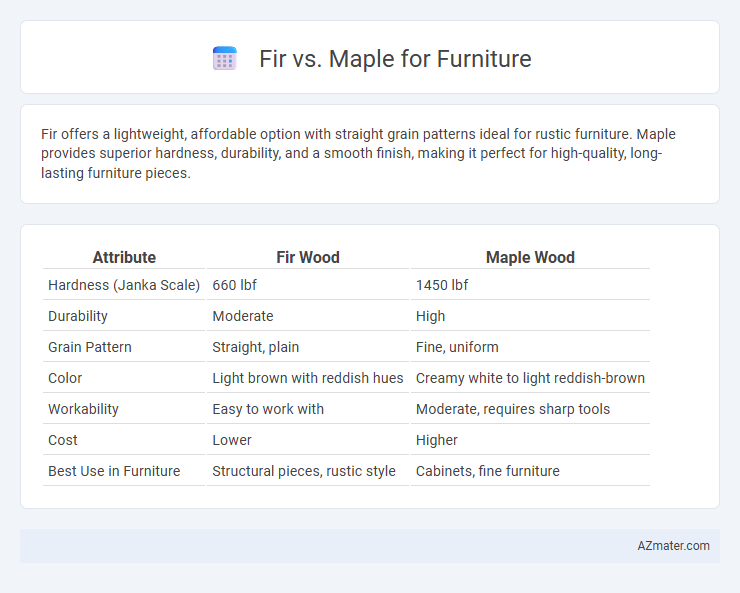Fir offers a lightweight, affordable option with straight grain patterns ideal for rustic furniture. Maple provides superior hardness, durability, and a smooth finish, making it perfect for high-quality, long-lasting furniture pieces.
Table of Comparison
| Attribute | Fir Wood | Maple Wood |
|---|---|---|
| Hardness (Janka Scale) | 660 lbf | 1450 lbf |
| Durability | Moderate | High |
| Grain Pattern | Straight, plain | Fine, uniform |
| Color | Light brown with reddish hues | Creamy white to light reddish-brown |
| Workability | Easy to work with | Moderate, requires sharp tools |
| Cost | Lower | Higher |
| Best Use in Furniture | Structural pieces, rustic style | Cabinets, fine furniture |
Introduction to Fir and Maple Wood
Fir wood, known for its strength and straight grain, offers excellent durability and workability, making it a popular choice for furniture that requires structural stability. Maple wood, characterized by its fine, uniform texture and natural hardness, provides a smooth finish and exceptional resistance to wear, ideal for high-traffic furniture pieces. Both fir and maple present unique qualities; fir excels in affordability and lightweight construction, while maple stands out for its aesthetic appeal and long-lasting performance.
Physical Characteristics: Fir vs Maple
Fir wood is lightweight with a straight grain and a pale yellow to reddish-brown color, offering moderate hardness and good stability but is prone to dents and scratches compared to hardwoods. Maple features a tight, fine grain pattern with a smooth texture and a creamy white to light reddish-brown hue, known for its exceptional hardness, durability, and resistance to wear. The denser structure of maple makes it more suitable for high-use furniture, while fir's softness allows for easier machining and a rustic appearance.
Durability and Strength Comparison
Fir wood offers moderate durability with a Janka hardness rating around 660, making it suitable for lightweight furniture but less resistant to dents and scratches compared to maple. Maple, especially hard maple, boasts a higher Janka hardness rating near 1450, providing superior strength, wear resistance, and longevity for heavy-use furniture applications. The denser grain structure of maple contributes to its enhanced durability, making it preferable for items requiring robust performance and long-term stability.
Appearance and Grain Patterns
Fir furniture features a straight, uniform grain with a light reddish-brown hue that darkens over time, creating a warm, rustic aesthetic ideal for casual or country-style interiors. Maple offers a smooth, fine grain with a pale cream to light reddish-brown color, known for its consistent pattern and subtle variations, lending a clean, elegant look perfect for modern or traditional settings. The choice between fir and maple depends on desired visual texture and color depth, with fir providing more pronounced grain contrast and maple delivering a refined, even appearance.
Workability and Ease of Use
Fir wood offers excellent workability due to its straight grain and softer texture, making it easier to cut, shape, and sand compared to Maple. Maple, while harder and denser, provides a smooth finish but requires sharper tools and more effort during machining, especially for intricate designs. Both woods are favored for furniture, but Fir is preferred for projects needing quick handling and ease in assembly, whereas Maple suits fine detailing and durability.
Cost and Affordability
Fir wood is generally more affordable than maple, making it a popular choice for budget-conscious furniture buyers. While fir offers good durability and a warm, natural appearance, maple tends to be pricier due to its hardness and fine grain, which provide a smoother finish and greater resistance to dents. Choosing fir can significantly reduce furniture costs without sacrificing structural integrity, especially for pieces that do not require the heavy-duty performance of hardwoods like maple.
Eco-Friendliness and Sustainability
Fir wood is highly valued for its rapid growth and carbon sequestration, making it an eco-friendly choice for sustainable furniture production. Maple, while slower-growing, offers exceptional durability and longevity, reducing the need for frequent replacements and thus lowering environmental impact over time. Both woods are widely sourced from responsibly managed forests, ensuring minimal ecological disruption when harvested sustainably.
Best Uses in Furniture Making
Fir wood offers excellent strength and stability, making it ideal for structural furniture components such as frames and legs, while its straight grain provides a rustic appearance suited for country-style pieces. Maple is prized for its hardness, fine grain, and smooth finish, making it perfect for high-use surfaces like tabletops, drawer fronts, and hardwood flooring, ensuring durability and a polished look. Both woods excel in furniture making, with fir favored for robust, cost-effective construction and maple preferred for refined, durable, and visually appealing finished pieces.
Maintenance and Longevity
Fir requires regular sealing or staining to protect against moisture and insect damage, making its maintenance moderately demanding compared to hardwoods. Maple's dense grain and natural resistance to wear and dents result in lower maintenance needs and a longer lifespan for furniture pieces. Choosing maple over fir ensures enhanced durability and less frequent upkeep, ideal for high-use furniture in busy households.
Choosing Between Fir and Maple for Your Furniture
Fir offers a lightweight, affordable option with a straight grain that is easy to work with, making it ideal for rustic or casual furniture styles. Maple provides a durable, dense hardwood known for its smooth grain and resistance to wear, suitable for pieces requiring longevity and a polished finish. Choosing between fir and maple depends on your budget, desired aesthetic, and the furniture's intended durability and use.

Infographic: Fir vs Maple for Furniture
 azmater.com
azmater.com